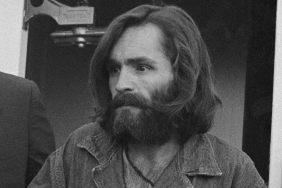
In 1969, one of the most bizarre and terrifying crimes in American history took place: the Manson Family cult killed seven people. The murders seemed to have been random, took place in the victim’s homes, and were characterized by shocking brutality and messages written in the blood of the victims. Perhaps more shocking than the crime itself was who perpetrated it: so-called peace-and-love hippies; white kids from “good families;” and a surprising number of females. Led by lifelong criminal Charles Manson, this high school dropout somehow convinced dozens of well-off teens and young adults to leave home and do his bidding.
It’s the kind of story that one would expect could only be found in the movies – so that’s exactly what producers did. Dozens of exploitation filmmakers jumped onto the “deranged sex-and-murder hippie cult” bandwagon, with films like Ray Danton’s THE DEATHMASTER, David Durston’s I DRINK YOUR BLOOD and the Findlays’ SLAUGHTER.
Slaughter was made by husband-and-wife team Michael and Roberta Findlay. The Findlays were well known in exploitation cinema for numerous “roughies” (cheap sexploitation films that often had violent, sadomasochistic, and/or horror elements), including their FLESH trilogy: THE TOUCH OF HER FLESH, THE CURSE OF HER FLESH and THE KISS OF HER FLESH. Shot in 1971 in Argentina on a budget of $30,000, SLAUGHTER was the Findlays’ way of cashing in on the Manson case, the trial for which had just ended. The film tells the tale of Satán, a cult leader who entices female followers to have sex with him and kill for him. One of the victims is an actress who happens to be pregnant at the time.

SLAUGHTER is a pretty terrible film, even for a time period characterized by terrible film. It was a rush job, with no original story points; even Roberta said it “made no sense.” But then distributor Allan Shackleton stepped in, and what would have been another forgotten film in the history of exploitation filmmaking became one of the most important exploitation films in history.
The term “snuff film” was first used by Ed Sanders in his 1972 book, The Family: The Story of Charles Manson’s Dune Buggy Attack Battalion. In the book, Sanders alleged that the Manson Family had made snuff films and buried them in the California desert. Multiple ground surveys and digs revealed no such films, and no evidence supporting such claims was ever found. But around this time, rumors were floating around, hinting that snuff films were being imported into the United States from South America.
For Shackleton, it was a perfect storm of elements. SLAUGHTER was too terrible to distribute as it was, so it sat on the shelf for a few years. Then Shackleton put the film’s terribleness to work with a new ending that makes the preceding 80 minutes inconsequential. SLAUGHTER just kind of ends after the “Tate” murders. Shackleton added five minutes of footage to the end. In the new footage, it shows a director calling cut on the previous murder scene, then the film crew wrapping up for the evening. A pretty production assistant admits to the director that the last scene turned her on, so as the set clears, the director talks the PA into messing around on one of the set beds. Rather than leave, the cameraman quietly flips on the camera and starts filming. As soon as the PA realizes she is being filmed, she fights back, and that’s when things get dark. The director produces a knife and eviscerates the girl as she screams and begs him to stop. The director disembowels the girl gleefully, then the film lead flickers by and the picture goes dark – they ran out of film. Before the audio cuts out, the cameraman assures the director that they got everything.

And that’s it. Rather than trying to cash in on the well-known hysteria of the Manson Family (which was no longer as scary, since most of Manson’s followers were behind bars at that time), Shackleton focused on a dark, obscure detail of the Manson legacy. It didn’t matter that the bulk of the film was borderline nonsensical; it was all leading up to the “shocking finale.” Shackleton removed all credits from the film, lending to the fiction that no one actually worked on the film (or wanted to be known to have worked on the film). The title was changed to SNUFF, and a legend was born.
Tacking on the infamous tag line, “Shot in South America… Where life is CHEAP!,” SNUFF gained instant notoriety. It became the subject of near-constant picketing no matter where it played. A number of feminist groups tried to get the district attorney in New York to prosecute one of the theater owners, but ironically, no charges could be brought for violence. It was only after the groups lodged complaints about the sex in the film that prosecutors were able to bring up obscenity charges.
Eventually it was revealed that SNUFF was a hoax. Almost immediately upon the film’s release in January 1976, critics proclaimed the murder of the young woman to be camera trickery. Police departments (most notably in New York, but also in Los Angeles) allegedly investigated the film, but were quick to find out that the young “production assistant” was alive and well, and the whole thing was a hoax. That didn’t stop the protests, and it shifted to a general anger over sexual violence towards women, and a government that could or would only prosecute consensual sex over non-consensual violence. This gave the film a longer life than it rightly should have had.

SNUFF is clearly not an actual snuff film. Nobody but the most naive, gullible viewer would believe that SNUFF features a real murder. Even still, when the film made it onto the home video market in the 1980s, Cult Video included copy that suggests the film was banned, went too far, that the actors and actresses were never seen or heard from again. It ends with the line: “Are the killings in this film real? You be the judge!”









